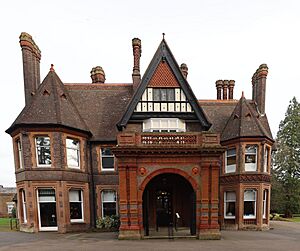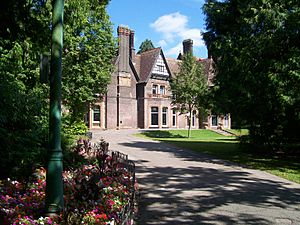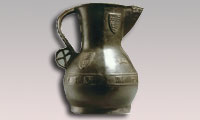Wardown Park Museum facts for kids

Wardown Park Museum
|
|
| Lua error in Module:Location_map at line 420: attempt to index field 'wikibase' (a nil value). | |
| Established | 1931 |
|---|---|
| Location | Wardown Park, Old Bedford Road, Luton, England |
| Type | Crafts of Bedfordshire |
Wardown House Museum and Gallery is a cool place to visit in Luton, England. It used to be called Wardown Park Museum. Before that, it was the Luton Museum & Art Gallery. This museum is inside a big, old Victorian mansion. You can find it in Wardown Park, just outside the town centre.
The museum has many interesting things to see. It focuses on old crafts from Bedfordshire. You can learn about lace-making and hat-making. There are even samples of Bedfordshire lace from the 1600s!
Contents
A Look Back in Time
The story of Wardown House began with Robert How. He built the first house in the park. It was called Bramingham Shott. This is the same building where the museum is today.
In the early 1870s, a local lawyer named Frank Chapman-Scargill took over the estate. He rebuilt much of the house in 1879. This work cost a lot of money, about £10,000 back then.
From Home to Park
Scargill left Luton in 1893. Then, a man named Benjamin John Harfield Forder bought the house and land. He renamed the estate "Wardown." This name came from a hill called War Down near his family home.
In 1903, Forder and his partners decided to sell the house. They also sold the 11-acre (4.5 ha) park. Luton Council bought the property in 1904. Over the next few years, many improvements were made. New trees were planted, and new paths and bridges were built. The park looks much the same today as it did back then. A bowling green was added in 1905.
A Hospital During Wartime
During the First World War, Wardown House became a hospital. It was first used by the Royal Army Medical Corps. Then, the British Red Cross Society used it. Mrs Nora Durler and Mrs Mary Green were in charge of the hospital. The Luton Museum moved into the house in 1931.
What You Can See
The museum has many different collections. It has about 700 hats and other headwear. You can see all kinds of hats from different times.
Local History and More
There is a special gallery about the Bedfordshire and Hertfordshire Regiment. This part of the museum was created by the Imperial War Museum. It tells the story of the local army regiment.
The galleries on the first floor were updated in 2003. They are called the Luton Life displays. These displays show stories of people from Luton over the last 150 years. The Heritage Lottery Fund helped pay for these updates.
On the ground floor, you can find the Living Landscape gallery. This area shows local archaeology and natural history. You can see the Shillington Roman coin hoard. There is also an Iron Age mirror on display.
The Wenlock Jug
The Wenlock Jug is a very special item at the museum. It is a rare bronze jug from the 1400s. It is important for learning about how bronze was made in medieval England.
In 2005, the jug was almost sold to a museum in New York. It was valued at £750,000. But the culture minister, David Lammy, stopped the sale. He wanted it to stay in England.
Luton Museums Service bought the jug instead. They paid a lot of money for it. It was 300 times their usual yearly budget for new items!
A Stolen Treasure
On May 14, 2012, the jug was stolen. This happened during a break-in at the Stockwood Discovery Centre in Luton. But don't worry, it was found! On September 24, 2012, it was recovered from a garage in Epsom. Now, it is safe back in the museum.



